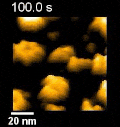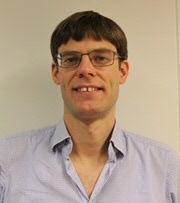Hoe viruseiwitten contact maken
Biofysici van de Rijksuniversiteit Groningen, de Vrije Universiteit Amsterdam en de Universiteit van Indiana te Bloomington hebben een oud vermoeden bevestigd over hoe virusdeeltjes gevormd worden. Volledig gevormde virusdeeltjes bestaan in de regel uit een zeer geordende structuur, waar elk virusomhulsel uit precies evenveel eiwitten bestaat. Er zijn echter ontelbaar manieren om de honderden eiwitten waaruit virussen opgebouwd zijn aan elkaar te plakken. Dus hoe lukt het om altijd hetzelfde, geordende eindresultaat te krijgen? De onderzoekers hebben nu laten zien dat in de cruciale eerste stappen van virusformatie de eiwitten altijd een structuur vormen waarin ze zoveel mogelijk buren hebben. Ze publiceerden hun resultaten 3 november in Science Advances.

Nanotechnologie
Virussen zijn in de natuur voorkomende nanodeeltjes gevuld met erfelijk materiaal. Biofysici proberen hun structuur op te helderen, als inspiratiebron voor de ontwikkeling van andere nanodeeltjes, maar ook om gerichter anti-virale medicijnen te kunnen ontwikkelen. Als je namelijk weet hoe virussen in elkaar worden gezet, kan je proberen medicijnen te ontwikkelen die dit proces te verstoren. Er zijn al veel modellen die de zelf-assemblage van virussen proberen te verklaren, maar kloppen die ook? De onderzoekers richtten zich op een idee dat de eerste stappen in dit proces plaatsvinden doordat de eiwitten aan elkaar gaan plakken op een manier waarin ze het grootst aantal contacten met buureiwitten aangaan, zogenaamde contact-rijke energieminima.
Filmen van contactformatie
De onderzoekers moesten een geavanceerde methode toepassen om op deze allerkleinste schaal de eiwitdynamica te kunnen volgen. Door met een optisch pincet de krachten te bepalen in de eerste stappen van assemblage, werd duidelijk dat de eiwitten het erfelijk materiaal op kunnen vouwen. Dat is essentieel om de lange genetische code in een klein eiwitbolletje - het virus – te kunnen proppen. Uit deze experimenten volgde echter nog niet hoe de eiwitten aan elkaar gaan zitten. Om dat te ontrafelen, werd een hele snelle tastmicroscoop gebruikt. Door het assemblage proces live te filmen, bleek dat de viruseiwitten elkaar zo lang aftasten totdat ze een geometrie hebben waarin het aantal contacten met de aanliggende eiwitten maximaal is. Alleen zulk structuren bleken levensvatbaar.

Hiermee heeft de groep van prof. dr. Wouter Roos, ondersteund door collega’s in binnen- en buitenland, aangetoond hoe de eerste stappen in virusassemblage plaatsvinden. Een belangrijke stap vooruit, want nu kan die kennis worden toegepast in nanotechnologische ontwikkelingen.
Referentie
Virus self-assembly proceeds through contact-rich energy minima
Pedro Buzón, Sourav Maity, Panagiotis Christodoulis, Monique J. Wiertsema, Steven Dunkelbarger, Christine Kim, Gijs J. L. Wuite, Adam Zlotnick, Wouter H. Roos
Science Advances Vol. 7, eabg0811 (2021)
https://doi.org/10.1126/sciadv.abg0811
Informatie/Contact
https://www.rug.nl/research/zernike/molecular-biophysics/roos-group/
